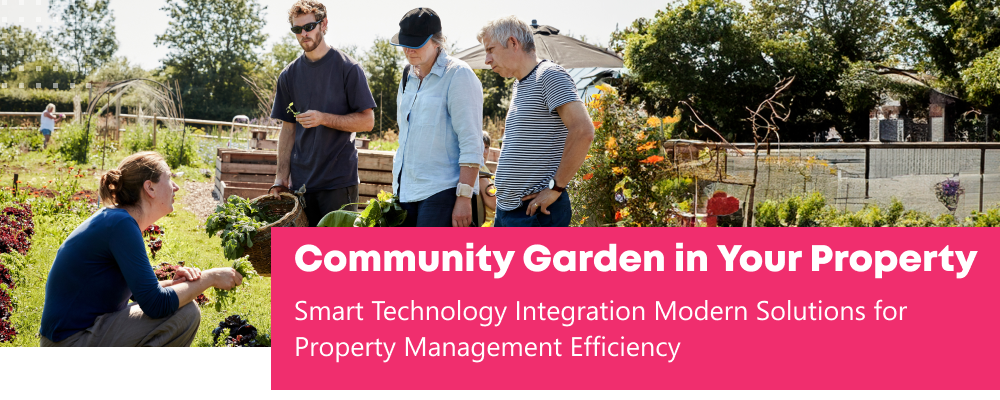Creating a Community Garden in Your Multi-Unit Property
As a real estate professional, I’m always looking for ways to improve the lives of my clients, both property owners and residents. One trend I’m increasingly excited about is the rise of community gardens in your property. These vibrant green spaces offer a wealth of benefits, fostering a sense of community, attracting new tenants, and even beautifying your property.
In this blog post, I’ll guide you through the entire process of creating a thriving community garden in your property. From gauging resident interest to choosing the perfect location and establishing clear guidelines, I’ll equip you with the knowledge and resources to make this project a success.
Gauging Resident Interest: The Seeds of Success
Before you break ground, it’s crucial to assess resident interest in a community garden. Consider conducting a survey or holding an open forum to gauge resident sentiment. This initial step allows you to tailor the garden’s design and purpose to best suit your residents’ needs. Are they interested in growing vegetables for fresh, healthy meals? Perhaps there’s a desire for a more ornamental garden with beautiful flowers and herbs. Understanding these preferences will ensure the garden is utilized and appreciated.
Location, Location, Location: Finding the Perfect Plot
Once you’ve confirmed resident interest, it’s time to find the ideal location for your community garden in your property. Look for a sunny spot with at least 6-8 hours of sunlight per day. Ensure the area has easy access to water and consider factors like drainage and existing utilities. Avoid locations near high-traffic areas or under power lines.
While aesthetics are important, prioritize functionality. Raised garden beds are a great option for multi-unit properties, particularly for balconies or rooftops. Raised beds offer improved drainage, easier maintenance for residents of varying abilities, and a defined garden space.
Planning and Design: From Seedlings to Structure
With a location chosen, it’s time to plan the layout and design of your community garden in your property. Here are some key considerations:
- Plot Sizes: Determine the size of individual plots based on resident interest and available space. Offer a variety of plot sizes to cater to different needs.
- Accessibility: Ensure the garden is accessible to all residents, regardless of physical limitations. Consider creating pathways with a smooth, even surface and incorporate raised beds for easier gardening.
- Water Source: Install a convenient and accessible water source for residents to maintain their plots. A spigot or hose bib strategically placed within the garden will be a welcome amenity.
- Storage: Provide a secure and weatherproof storage shed or lockers for residents to keep their gardening tools and supplies.
- Composting: Consider incorporating a designated composting area where residents can recycle kitchen scraps and yard waste to create nutrient-rich compost for their plots.
Building a Community: From Germination to Growth
A community garden in your property more than just plants and soil; it’s a space for residents to connect and build relationships. Here are some ways to foster a sense of community within your garden:
- Garden Committee: Establish a resident-led committee to oversee garden operations, schedule planting days, and address any concerns.
- Workshops and Events: Organize workshops on gardening techniques, seed selection, or composting. Host social events like potlucks or harvest festivals to encourage resident interaction.
- Communication: Create a communication platform, such as a bulletin board or online forum, for residents to share gardening tips, swap seeds, and coordinate plot usage.
Establishing Clear Guidelines: Nurturing Respect and Responsibility
To ensure the long-term success of your community garden, it’s vital to establish clear and concise garden guidelines. These guidelines should address:
- Plot Usage: Outline expectations for plot maintenance, planting restrictions (if any), and consequences for neglect.
- Water Conservation: Encourage responsible water usage with designated watering times or odd-even watering schedules.
- Pest Management: Establish guidelines for organic pest control methods to promote a healthy and sustainable garden environment.
- Conflict Resolution: Develop a clear process for addressing any disputes that may arise among residents regarding the garden.
By establishing these guidelines, you create a framework for responsible gardening practices and promote a sense of shared ownership within the community.
Conclusion
Creating a community garden in your property can be a rewarding and enriching experience. From fostering resident engagement to beautifying your property and attracting new tenants, the benefits are plentiful. By following the steps outlined in this blog post, you can transform a simple patch of land into a vibrant hub of community and sustainable living. Remember, the key to a thriving community garden lies in resident buy-in, thoughtful planning, and clear communication. With a little effort, you can cultivate a space that not only yields fresh produce but also fosters a sense of connection and shared purpose among your residents.
Additional resources to help you on your journey:
- The American Community Gardening Association: This organization provides a wealth of resources on creating and managing community gardens, including sample garden rules and helpful planning guides.
- Your Local Extension Office: Your local extension office can offer valuable advice on plant selection, sustainable gardening practices, and pest management specific to your region.
- Optivo Group Property Management Services: At Optivo Group, we understand the importance of creating a thriving community for your residents. Contact us today to discuss how our property management services can help you navigate the process of creating and maintaining a successful community garden in your multi-unit property.
